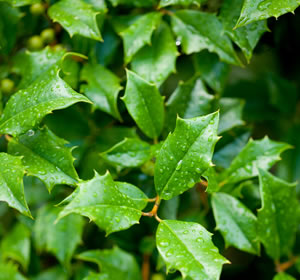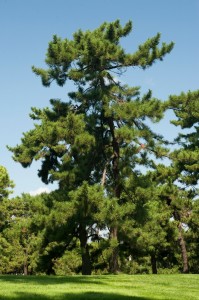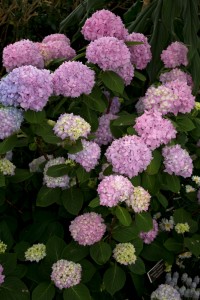Gardening by the Sea: Shrubs & Trees
Posted in Gardening Tips on December 3 2013, by Sonia Uyterhoeven
Sonia Uyterhoeven is the NYBG‘s Gardener for Public Education.

I was recently sent a number of questions from readers still dealing with the aftermath of Hurricane Sandy in their gardens. Many of the questions pertained to planting privacy screens that can withstand the perils of the sea. These protective plants are broken into primary dune plants; plants that commonly grow on the dunes closest to the ocean, and secondary dune plants; plants that grow on the backside of dunes and on dunes that are protected by primary dunes.
When planning a seaside garden, this privacy screen serves a secondary purpose in protecting more sensitive plants from wind and sea spray. Despite this protection, it is still important to choose your garden plants carefully, as they must be able to withstand sea spray, bright sunlight, periodic dessication, intermittent inundation, and poor soil nutrition. I discuss these considerations and give a list of good plants for these conditions here.

There are a number of candidates for coastal privacy screens. One good choice is the evergreen Eastern red cedar, Juniperus virginiana. It is a tough evergreen tree with lovely bark that can adapt to almost any environment, though it is not a candidate for front line defense of your property from the sea, and requires a degree of protection itself. Eastern red cedar needles get a bronze cast in winter. It is important to keep an eye out for apple-cedar rust, a disease which can occur when Eastern red cedars and apples, hawthorns, or crabapples—all members of the Malus genus—are planted in close proximity to each other. Apple-cedar rust is a fungal disease that produces strange looking galls on red cedars and disfigures and often defoliates apple trees.
Another good secondary dune evergreen option is American holly, Ilex opaca. In nature you will not find American holly in the primary dunes, but it can often be found growing nearby. A bonus of creating a privacy screen of American hollies is that when the foliage gets damaged by salt you can cut it almost to the ground and it will bounce back like a champion. American hollies are dioecious and need a male and female for the female to produce the holly’s iconic red late season berries.

Two of my favorite beach-loving shrubs are bayberry, Myrica/Morella pensylvanica and beach plum Prunus maritima. Bayberry grows 5 to 10 feet tall, but in sandy coastal areas where it is shaped by the wind it tends to stay more compact. Beach plum will grow 4 to 10 feet tall, but I generally see them between 4 to 6 feet on Cape Cod. Bayberry is semi-deciduous and beach plum is deciduous with a great branching structure and exquisite fruit.
One shrub/small tree that I am just getting to know is the wonderful sea myrtle or groundsel tree, Baccharis halimifolia. It is a deciduous shrub that grows 6 to 12 feet tall (generally pushing the upper limits of its size) that has dense branching so it provides a nice screen. It is also dioecious with the female producing achenes (dry, one-seeded fruit) in the fall that look like silken white paintbrushes. I see this growing along the highway from New York to New Jersey. It is a tough customer that thrives in salty environments.
Some of my favorites on the list below are the chokeberries and serviceberry. They are great for attracting birds and have attractive fruit and wonderful fall color. In terms of good varieties, look for red chokeberry, Aronia arbutifolia ‘Brilliantissima’ and black chokeberry, Aronia melanocarpa ‘Viking’.
The trees and shrubs are separated into Belt 1 plants that tolerate the elements well and can be planted close to the beach, and Belt 2 plants that need some protection from the sea.
Seaside Trees and Shrubs
Key – the plants followed by an asterisk (*) are native plants.
Belt 1: Plants that can tolerate a great deal of wind, salt spray and sand
Seaside alder Alnus maritima*
Sea myrtle or groundsel tree Baccharis halimifolia*
Smoke tree C0tinus coggygria
Cockspur hawthorn Crataegus crus-galli*
Bayberry Myrica/Morella pensylvanica*
Norway spruce Picea abies
Japanese black pine Pinus thunbergii
Beach plum Prunus maritima*
Scarlet oak Quercus coccinea*
Beach rose Rosa rugosa – Warning: Beach rose has invasive tendencies, try cultivars such as ‘Frau Dagman Hastrup’, ‘Belle Poitevine’ and ‘Blanc Double de Coubert’.
Belt 2: Trees and shrubs that can tolerate some wind, salt spray, and sand but perform best in areas that offer some protection from the sea
Serviceberry Amelanchier canadensis*
Red chokeberry Aronia arbutifolia*
Black chokeberry Aronia melanocarpa, ‘Viking’*
Gray birch Betula populifolia*
Bluebeard Caryopteris x clandonensis
Atlantic white cedar Chamaecyparis thyoides*
Summersweet Clethra alnifolia*
Cotoneaster Cotoneaster
English hawthorn Crataegus laevigata
Deutzia Deutzia scabra
Bigleaf hydrangea–mophead and lacecap Hydrangea macrophylla
Panicle hydrangea Hydrangea paniculata
Oakleaf hydrangea Hydrangea quercifolia
American holly Ilex opaca*
Inkberry Ilex glabra*
Blue or meserve holly Ilex x meserveae
Chinese juniper Juniperus chinensis- Some are prostrate and others upright so look for taller cultivars such as ‘Hetzii’, ‘Blue Point’ ‘Robusta Green,’ and ‘Sea Green’ if you want a screen.
Eastern red cedar Juniperus virginiana*
Spicebush Lindera benzoin*
Sweetbay magnolia Magnolia virginiana*
Sargent’s crabapple Malus sargentii
Austrian pine Pinus nigra
Pitch pine Pinus rigida*
London plane Platanus x acerifolia
Purple leaf sand cherry Prunus x cistena
White oak Quercus alba*
Red oak Quercus rubra*
Smooth sumac Rhus glabra*
Swamp or Carolina rose Rosa Carolina*
Virginia rose Rosa virginiana*
Pussy willow Salix discolor*
Lilac Syringa vulgaris
Bald cypress Taxodium distichum*
Highbush blueberry Vaccinium corymbosum*
Arrowwood Viburnum dentatum*
Black haw Viburnum prunifolium*

